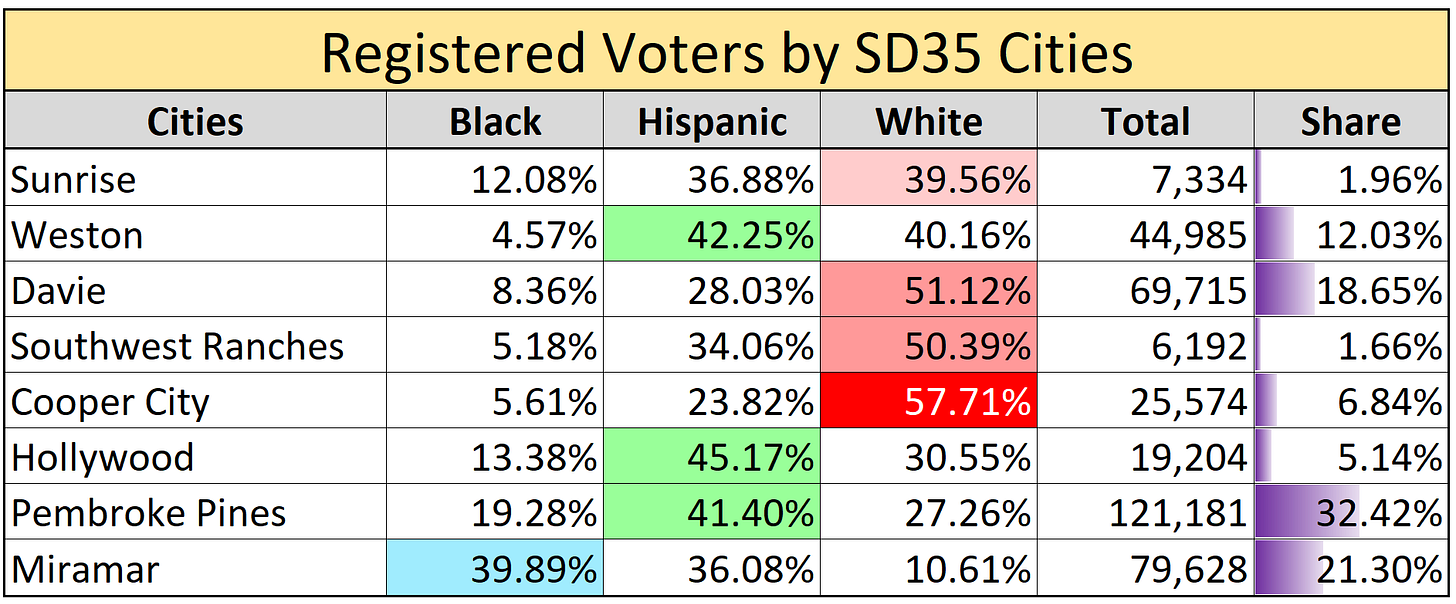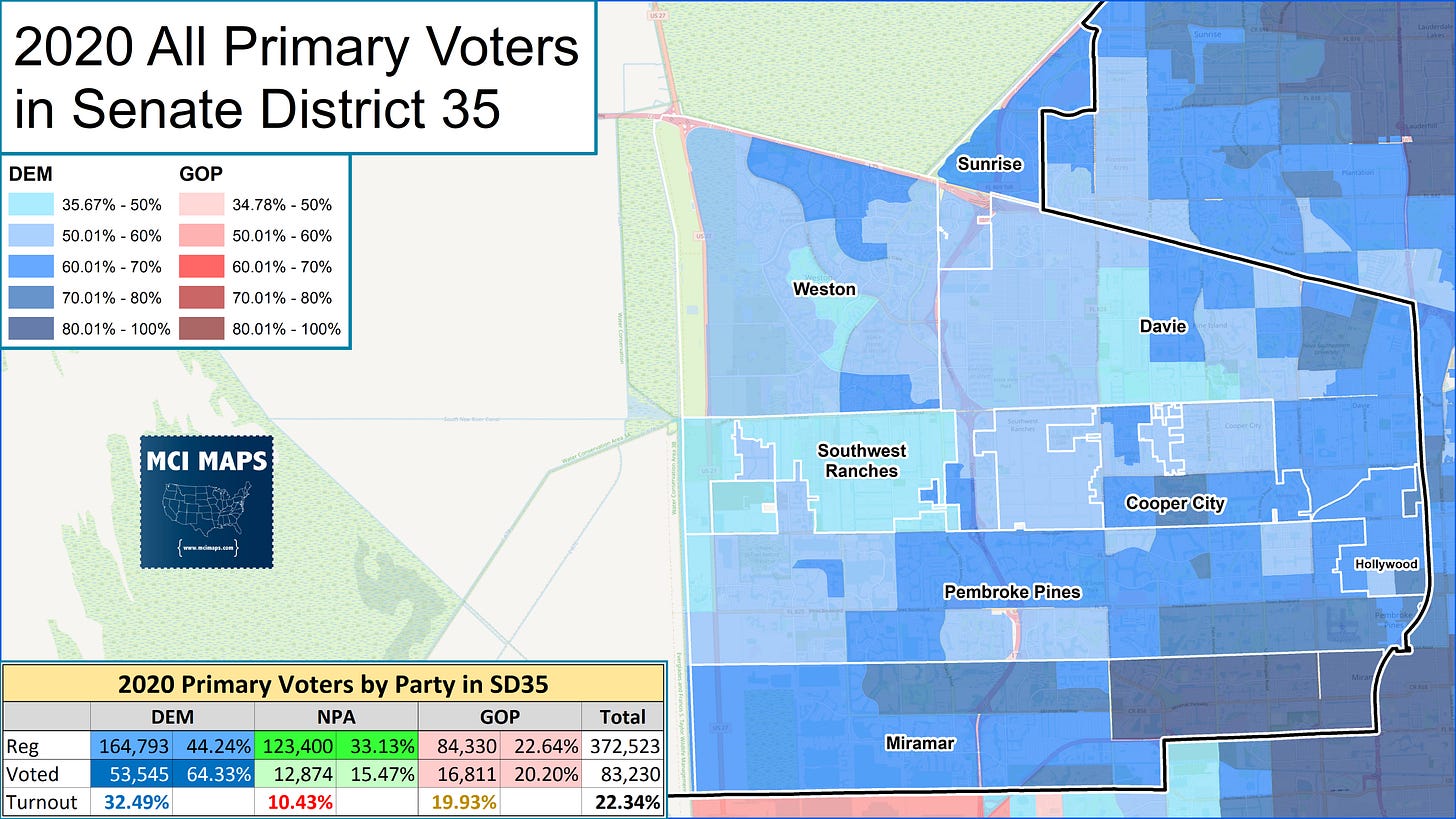Issue #61: How FL Senate 35's Demographics Change now that its an Open Primary
The opening to NPA's and Republicans likely helps Book
Back in March, I looked into the then-emerging Democratic Primary for State Senate District 35. The primary, which pits Incumbent Senator Lauren Book against former County Commissioner Barbara Sharief, has proven to be a nasty and expensive affair.
Book, who has represented the bulk of the district since her 2016 election, saw her seat be redrawn in the redistricting process. The final lines put her house just outside the district, on the other side of 595. The final lines put her in SD32, which is a black-performing district represented by Senator Rosalind Osgood. Book said she intended to move into the district. Things got more complicated when Sharief, who hails from Miramar, jumped into the race.
This move guaranteed a multi-million dollar primary. Book, the daughter of a prominent lobbyist, is a stellar fundraiser and is the current Senate Democratic leader. Sharief, who recently came off a loss in the special election to replace Alcee Hastings in Congress, poses a real challenge to the Senator. Her base is in the Democrat-heavy south-end of the district.
I recommend re-reading my March article for more details. However, a quick recap of the new district. The area is very diverse in both ethnicity and socio-economics. The 2020 census data is 46% Hispanic, 26% white, 21% black. The black community is also a mix of Caribbean and non-Caribbean black residents. The area is heavily suburban; filled with bedroom communities and new developments. Broadly speaking, the upper-income suburbs cover the west end of the district, while renters and smaller homes populate the east end.
A closed primary in the district would have been around 35% black, 34% white, and 19% Hispanic. This can fluctuate based on turnout. Hispanic voters suffer from weaker turnout, allowing black and white voters to outpace them. The map below shows Democratic registration by precinct.
These demographics made Book’s re-election tough. While she is well respected, perhaps best known for her charity work; especially Lauren’s Kids, which focuses on child abuse; she has never actually been on a ballot. Her 2016 election, and all re-elections, have been unopposed. While she did make herself known in the district, she did not represent the Miramar region until this round of redistricting.
Book is not well known in the heavily-black communities that are concentrated in the south of the district. This gives Sharief, a well-known figure in the area, a solid opening to grab votes. While I believed Book to be favorite, without a doubt able to fundraise heavily, it was still going to be a tough fight. Sharief dropped $500,000 of her own money into the race, which made up for lackluster fundraising. The prospect that Republicans might get involved; just to screw with the Democratic leader, was a real possibility. Democratic groups quickly worked to back up Book. Fellow Senator Jason Pizzo, who won re-election unopposed, pledge money to Book. She secured backing from the AFL-CIO, Teachers Union, and bulk of her fellow Democratic Senators. Between Book’s official campaign account and affiliated committees, the Senator has raised millions for the race.
Almost from day one, the race was nasty. Many Democratic leaders fumed at the primary challenge; pointing out Book only has two years left before term limits kick in. Sharief, they argue, could have run then. Sharief has countered that Book doesn’t live in the district, so its not a primary of an incumbent. Both have hit each-other on different issues, with most observers agreeing Book’s political base is in the North, while Sharief’s base is in the south.
Primary Opens Up
The dynamics of the race took a slight turn in June when the Republican candidate , Vincent Parlatore, dropped out. Vincent’s initial candidacy closed the democratic primary. However, it turned out that as qualifying came to an end, he switched races to House District 105. With Book and Sharief the only candidates left in the race, Florida law mandated the primary open up to all voters. While the seat is heavily Democratic, this did mean GOP and NPA voters would get the option to vote on the race. So how does that change the demographics of the district?
When looking at all registered voters, the district is 36% Hispanic, 33% white, and 18% black. If we look at just registration, the biggest change is Hispanic voters become the largest group. See the changes to share of registration below.
The change benefits Hispanic and white voters the most, but hinders black voters. This actually makes sense, as most black voters are already democratic. This is why open primaries can often “bleach” races - something I discussed here and here.
The registration by precinct map for the district is below.
Voters are heavily concentrated in Pembroke Pines, Miramar, Davie, and Weston. The ethnic breakdown of registered voters by city can be seen below.
There are also under 100 likely voters in the portion of the Seminole reservation that is within the district.
Miramar, which is Sharief’s political base, is 21% of registered voters. Pembroke Pines is the largest voting block; which Sharief represented a piece of on the commission. However, the city overall is up for grabs between both candidates.
While the district is plurality Hispanic in registration, likely voter turnout changes the dynamic. Hispanic voters still suffer from weaker turnout. As a result, white voters are likely to be the largest voting block. The 2020 primary turnout within the district came out to 38% white, 26% black, and 26% Hispanic.
Each cycle sees an increase in the non-white share of the vote. However, for 2022, we are very likely looking at white voters being the largest voting block by 10 or so points.
This change is very likely a benefit to the Book campaign overall. As I discussed in my March article, many voters in the district are not de-factor prone to race-based voting. Sharief absolutely could make inroads with white voters. Conversely, Book good make inroads with black voters. Hispanic voters, which are not a monolithic block, made up of different national groups and with varied economic profiles, are up for grabs. However, there is no denying Sharief’s base was in the black community; which has just seen its share of the vote drop.
Another note, Democrats will remain a dominant share of the likely primary vote. In fact, the 2020 primary saw Democrats as the largest voting black in every precinct within the city.
NPA voters, who cannot vote in the top statewide primaries, have far weaker turnout than Democrats or Republicans. The 2020 primaries had little contentious GOP primaries to turn out Republicans, while Democrats showed up for several countywide primaries. This go around, the Democrats have this primary and a Gubernatorial primary bringing folks to the polls. While Republican voters are energized to vote (classic midterm symptom of being out of power) - I venture their turnout will still trail Democrats in Broward. The turnout gap may not be so large, however.
My view on the race has not changed. Book is the likely frontrunner for the seat. That said, its by no means over. If Book winds up winning by a solid 10, 15, or 20 point margin, then I’d say the opening of the primary carries little impact. If the race is decided by just a couple points, however, then we could argue it made a big difference.












